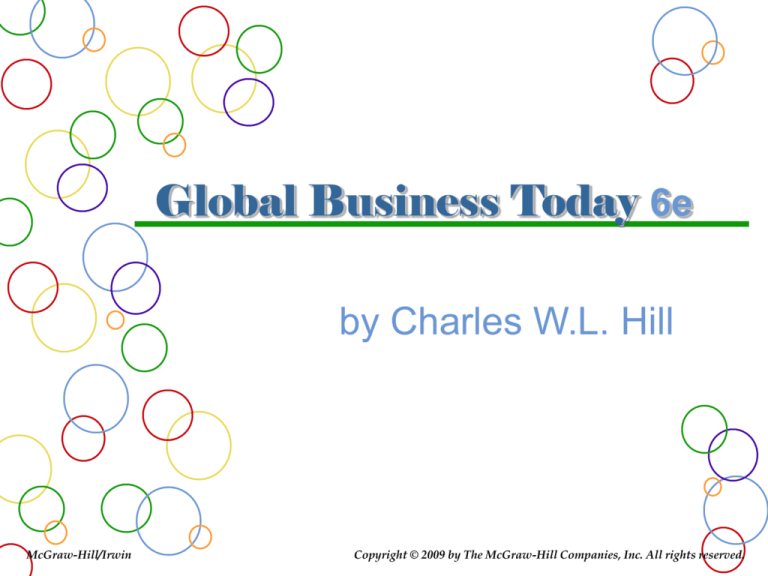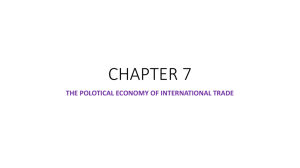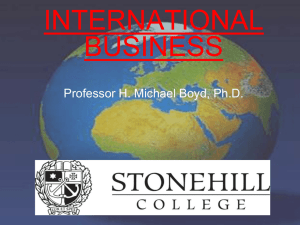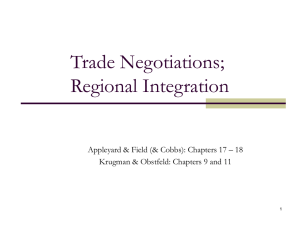
Global Business Today 6e
by Charles W.L. Hill
McGraw-Hill/Irwin
Copyright © 2009 by The McGraw-Hill Companies, Inc. All rights reserved.
Chapter 6
The Political Economy
of International Trade
Introduction
Free trade refers to a situation where a
government does not attempt to restrict
what its citizens can buy from another
country or what they can sell to another
country
While many nations are nominally
committed to free trade, they tend to
intervene in international trade to protect
the interests of politically important
groups
6-3
Instruments of Trade Policy
Question: How do governments intervene in
international trade?
There are seven main instruments of trade
policy
1. Tariffs
2. Subsidies
3. Import quotas
4. Voluntary export restraints
5. Local content requirements
6. Antidumping policies
7. Administrative policies
6-4
Tariffs
A tariff is a tax levied on imports that
effectively raises the cost of imported
products relative to domestic products
Specific tariffs are levied as a fixed
charge for each unit of a good
imported
Ad valorem tariffs are levied as a
proportion of the value of the imported
good
6-5
Tariffs
Question: Why do governments impose tariffs?
Tariffs
increase government revenues
provide protection to domestic producers
against foreign competitors by increasing the
cost of imported foreign goods
force consumers to pay more for certain
imports
So, tariffs are unambiguously pro-producer and
anti-consumer, and tariffs reduce the overall
efficiency of the world economy
6-6
Classroom Performance System
A tariff levied as a fixed charge for each
unit of a good imported is a(n)
a) Fixed tariff
b) Specific tariff
c) Ad valorem tariff
d) Transit tariff
6-7
Subsidies
A subsidy is a government payment to a
domestic producer
Subsidies help domestic producers
compete against low-cost foreign
imports
gain export markets
Consumers typically absorb the costs of
subsidies
6-8
Import Quotas and
Voluntary Export Restraints
An import quota is a direct restriction on the
quantity of some good that may be imported
into a country
Tariff rate quotas are a hybrid of a quota and a
tariff where a lower tariff is applied to imports
within the quota than to those over the quota
Voluntary export restraints are quotas on trade
imposed by the exporting country, typically at
the request of the importing country’s
government
A quota rent is the extra profit that producers
make when supply is artificially limited by an
import quota
6-9
Import Quotas and
Voluntary Export Restraints
Question: Who benefits from import
quotas and voluntary export restraints?
Import quotas and voluntary export
restraints benefit domestic producers by
limiting import competition, but they raise
the prices of imported goods for
consumers
6-10
Local Content Requirements
A local content requirement demands
that some specific fraction of a good be
produced domestically
The requirement can be in physical
terms or in value terms
Local content requirements benefit
domestic producers and jobs, but
consumers face higher prices
6-11
Administrative Policies
Administrative trade polices are
bureaucratic rules that are designed to
make it difficult for imports to enter a
country
These polices hurt consumers by
denying access to possibly superior
foreign products
6-12
Administrative Policies
Dumping is selling goods in a foreign market
below their cost of production, or selling goods
in a foreign market at below their “fair” market
value
It can be a way for firms to unload excess
production in foreign markets
Some dumping may be predatory behavior,
with producers using substantial profits from
their home markets to subsidize prices in a
foreign market with a view to driving
indigenous competitors out of that market,
and later raising prices and earning
substantial profits
6-13
Administrative Policies
Antidumping polices are designed to
punish foreign firms that engage in
dumping
The goal is to protect domestic
producers from “unfair” foreign
competition
U.S. firms that believe a foreign firm is
dumping can file a complaint with the
government
If the complaint has merit, antidumping
duties, also known as countervailing
duties may be imposed
6-14
Classroom Performance System
A quota on trade imposed from the
exporting country’s side is a(n)
a) Voluntary export restraint
b) Quota rent
c) Local content requirement
d) Administrative trade policy
6-15
The Case for
Government Intervention
Question: Why do governments intervene in
trade?
There are two types of arguments
1. Political arguments are concerned with
protecting the interests of certain groups
within a nation (normally producers), often
at the expense of other groups (normally
consumers)
2. Economic arguments are typically
concerned with boosting the overall wealth
of a nation (to the benefit of all, both
producers and consumers)
6-16
Political Arguments for Intervention
Political arguments for government
intervention include
1. protecting jobs
2. protecting industries deemed important for
national security
3. retaliating to unfair foreign competition
4. protecting consumers from “dangerous”
products
5. furthering the goals of foreign policy
6. protecting the human rights of individuals in
exporting countries
6-17
Political Arguments for Intervention
1. Protecting jobs and industries
This is the most common political
reason for trade restrictions
This is typically the result of political
pressures by unions or industries that
are "threatened" by more efficient
foreign producers, and have more
political clout than the consumers who
will eventually pay the costs
6-18
Political Arguments for Intervention
2. National Security
Governments sometimes protect
certain industries such as aerospace or
advanced electronics because they are
important for national security
This argument is less common today
than in the past
6-19
Political Arguments for Intervention
3. Retaliation
When governments take, or threaten to
take, specific actions, other countries
may remove trade barriers
This can be a risky strategy
If threatened governments don’t back
down, tensions can escalate and new
trade barriers may be enacted
6-20
Political Arguments for Intervention
4. Protecting Consumers
Protecting consumers from unsafe
products is also be an argument for
restricting imports
This often involves limiting or banning
the import of certain products
6-21
Political Arguments for Intervention
5. Furthering Foreign Policy Objectives
Trade policy can be used to support foreign
policy objectives
Preferential trade terms can be granted to
countries that a government wants to build
strong relations with
Rogue states that do not abide by
international laws or norms can be punished
However, it might cause other countries to
undermine unilateral trade sanctions
Two acts, the Helms-Burton Act and the
D’Amato Act, have been passed to protect
American companies from such actions
6-22
Political Arguments for Intervention
6. Protecting Human Rights
Governments can use trade policy to improve
the human rights policies of trading partners
Unless a large number of countries choose
to take such action, however, it is unlikely to
prove successful
Some critics have argued that the best way to
change the internal human rights of a country is
to engage it in international trade
The decision to grant China MFN status in
1999 was based on this philosophy
6-23
Economic Arguments
for Intervention
Economic arguments for government
intervention in international trade
include
1. The infant industry argument
2. Strategic trade policy
6-24
Economic Arguments
for Intervention
1. The infant industry argument
The infant industry argument suggests that an
industry should be protected until it can develop
and be viable and competitive internationally
This has been accepted as a justification for
temporary trade restrictions under the WTO
However, this argument has been criticized
because
it is useless unless it makes the industry
more efficient
if a country has the potential to develop a
viable competitive position, its firms should
be capable of raising necessary funds
Critics argue that
6-25
Economic Arguments
for Intervention
2. Strategic Trade Policy
Strategic trade policy suggests that in
cases where there may be important first
mover advantages, governments can
help firms from their countries attain
these advantages
Strategic trade policy also suggests that
governments can help firms overcome
barriers to entry into industries where
foreign firms have an initial advantage
6-26
Classroom Performance System
Which argument for government
intervention suggests that an industry
should be protected until it can develop
and be viable and competitive
internationally?
a) Strategic trade policy
b) National security
c) Retaliation
d) Infant industry
6-27
The Revised Case for Free Trade
New trade theorists believe government
intervention in international trade is justified
Classic trade theorists disagree
Some new trade theorists believe that while
strategic trade theory is appealing in theory, it
may not be workable in practice – they suggest
a revised case for free trade
Two situations where restrictions on trade may
be inappropriate
Retaliation
Domestic Policies
6-28
Retaliation and War
Krugman argues that strategic trade
policies aimed at establishing domestic
firms in a dominant position in a global
industry are beggar-thy-neighbor policies
that boost national income at the
expense of other countries
A country that attempts to use such
policies will probably provoke retaliation
A trade war could leave both countries worse
off
6-29
Domestic Policies
Governments can be influenced by
special interest
Consequently, a government’s decision
to intervene in a market may appease a
certain group, but not necessarily the
support the interests of the country as a
whole
6-30
Development of
the World Trading System
Since World War II, an international
trading framework has evolved to govern
world trade
In its first fifty years, the framework was
known as the General Agreement on
Tariffs and Trade (GATT)
Since 1995, the framework has been
known as the World Trade Organization
(WTO)
6-31
From Smith to the Great Depression
Up until the Great Depression of the
1930s, most countries had some degree
of protectionism
In 1930, the U.S. enacted the SmootHawley Act, which created significant
import tariffs on foreign goods
Other nations took similar steps and as
the depression deepened, world trade
fell further
6-32
1947-1979: GATT, Trade Liberalization,
and Economic Growth
After WWII, the U.S. and other nations realized
the value of freer trade, and established the
General Agreement on Tariffs and Trade in 1947
The approach of GATT (a multilateral
agreement to liberalize trade) was to gradually
eliminate barriers to trade
GATT’s membership grew from 19 to more
than 120 nations
Tariff reduction was spread over eight rounds
of negotiation
GATT regulations were enforce by a mutual
monitoring system
6-33
1980-1993: Protectionist Trends
The world trading system came under strain
during the 1980s and early 1990s because
Japan’s economic success strained what
had been more equal trading patterns
Persistent trade deficits by the U.S caused
significant problems in some industries and
political problems for the government
Many countries found that although GATT
limited the use of tariffs, there were many
other forms of intervention that had the same
effect that did not technically violate GATT
6-34
The Uruguay Round and
the World Trade Organization
The Uruguay Round (1986) focused on
1. Services and Intellectual Property
Trade issues related to services and
intellectual property and agriculture were
emphasized
2. The World Trade Organization
The WTO was established as a more
effective policeman of the global trade rules
The WTO encompassed GATT and the
General Agreement on Trade in Services
(GATS) and the Agreement on Trade
Related Aspects of Intellectual Property
Rights (TRIPS)
6-35
WTO Experience to Date
Since its establishment, the WTO has emerged
as an effective advocate and facilitator of future
trade deals, particularly in such areas as
services
So far, most countries have adopted WTO
recommendations for trade disputes
The WTO has brokered negotiations to
reform the global telecommunications and
financial services industries
The 1999 meeting of the WTO in Seattle
demonstrated that issues surrounding free
trade have become mainstream, and
dependent on popular opinion
6-36
The Future of the WTO: Unresolved
Issues and the Doha Round
The WTO is currently focusing on
1. Anti-dumping policies
The WTO is encouraging members to strengthen the
regulations governing the imposition of antidumping
duties
2. Protectionism in agriculture
The WTO is concerned with the high level of tariffs and
subsidies in the agricultural sector of many economies
3. Protecting intellectual property
Members believe that the protection of intellectual
property rights is essential to the international trading
system
TRIPS obliges WTO members to grant and enforce
patents lasting at least 20 years and copyrights lasting
50 years
6-37
The Future of the WTO: Unresolved
Issues and the Doha Round
4. Market access for nonagricultural goods and services
The WTO would like to bring down tariff rates on
nonagricultural goods and services, and reduce the
scope for the selective use of high tariff rates
5. A new round of talks: Doha
The WTO launched a new round of talks in 2001 to
focus on
cutting tariffs on industrial goods and services
phasing out subsidies to agricultural producers
reducing barriers to cross-border investment
limiting the use of anti-dumping laws
6-38
Classroom Performance System
The main issues on the table at the Doha
Round include all of the following except
a) Anti-dumping policies
b) Protectionism in agriculture
c) Intellectual property rights
d) Infant industry protection
6-39
Implications for Managers
Question: Why should international
managers care about the political
economy of free trade or about the
relative merits of arguments for free
trade and protectionism?
Trade barriers impact firm strategy
Firms can play a role in promoting free
trade or trade barriers
6-40
Trade Barriers and Firm Strategy
Trade theory suggests why dispersing
production activities globally can be beneficial
However, trade barriers may limit a firm’s ability
to do so
Trade barriers raise the cost of exporting
Quotas limit exports
Firms may have to locate production
activities within a country to meet local
content regulations
The threat of future trade barriers can
influence firm strategy
All of these can raise costs above what they
may have been in a world of free trade
6-41
Policy Implications
International firms have an incentive to
lobby for free trade, and keep
protectionist pressures from causing
them to have to change strategies
While there may be short run benefits to
having government protection in some
situations, in the long run these can
backfire and other governments can
retaliate making it more difficult to
construct a globally dispersed production
system
6-42
Critical Discussion Question
1. Do you think the U.S. government
should consider human rights when
granting preferential trading rights to
countries? What are the arguments for
and against taking such a position?
6-43
Critical Discussion Question
2. Whose interests should be the
paramount concern of government trade
policy - the interests of producers
(businesses and their employees) or
those of consumers?
6-44
Critical Discussion Question
3. Given the arguments relating to the new
trade theory and strategic trade policy,
what kind of trade policy should business
be pressuring government to adopt?
6-45
Critical Discussion Question
4. You are an employee of an U.S. firm that produces
personal computers in Thailand and then exports them to
the U.S. and other countries for sale. The personal
computers were originally produced in Thailand to take
advantage of relatively low labor costs and a skilled
workforce. Other possible locations considered at that
time were Malaysia and Hong Kong. The U.S.
government decides to impose punitive 100 percent ad
valorem tariffs on imports of computers from Thailand to
punish the country for administrative trade barriers that
restrict U.S. exports to Thailand. How should your firm
respond? What does this tell you about the use of
targeted trade barriers?
6-46
Critical Discussion Question
5. Reread the Management Focus feature
on U.S. Magnesium Seeks Protection.
Who gains most from the anti-dumping
duties levied by the United States on
imports of magnesium from China and
Russia? Who are the losers? Are these
duties in the best national interests of the
United States?
6-47





